The Four Horsemen of the Apocalypse
The Four Horsemen of the Apocalypse
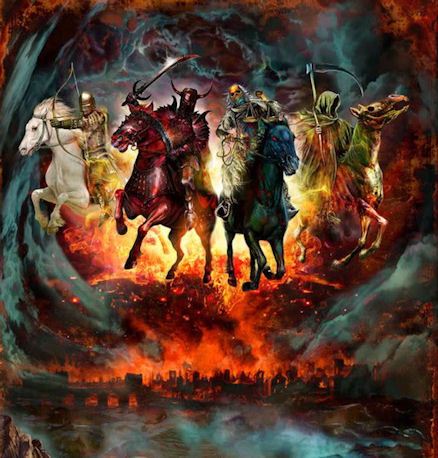 Who are they?
Who are they?
The Four Horsemen of the Apocalypse are The Conqueror or Pestilence who is also in some cases called the Antichrist.; War; Famine and Death. The Book of Revelations tells of Four Horsemen of the Apocalypse. in the last book of the New Testament. It mentions a book or scroll (broken down it is the title deed to the the Earth in Revelations chapter 5) Jesus said that Satan is now the god of our world. Revelations is the story of how Jesus gets the title deed to his world back. The title deed is a rolled up scroll sealed by seven drops of wax. As Jesus begins to undo each of the wax seals, events on earth really heat up. The first seals are often referred to as the Four Horsemen of the Apocalypse. The term “Apocalypse,” means “Revelation”. in God’s right hand that is sealed with seven seals”. The Lamb of God, or Lion of Judah, (Jesus Christ) opens the first four of the seven seals, which summons forth four beings that ride out on white, red, black, and pale horses. Although some interpretations differ, in most accounts, the four riders are seen as symbolizing Conquest, War, Famine, and Death, respectively. The Christian apocalyptic vision is that the four horsemen are to set a divine apocalypse upon the world as harbingers of the Last Judgment..
The White Horse:
I watched as the Lamb opened the first of the seven seals. Then I heard one of the four living creatures say in a voice like thunder, “Come and see!” I looked, and there before me was a white horse! Its rider held a bow, and he was given a crown, and he rode out as a conqueror bent on conquest. ( Revelation 6:1-2)
Also called Conquest, the Conqueror, Pestilence, Plague and the Antichrist
This verse does not say who rides this “white horse.” However, it is most likely the coming Antichrist (Daniel 9:26-27; 1 Thessalonians 5:3). This rider represents a conquering power that no one can resist (Matt 24:3-6). This person is not Christ (cf. Rev 19:11-19). He is Satan's counterfeit of Christ The first seal opens at the beginning of the final 7-year “tribulation” leading up to the second coming. The white horse and rider represent three and a half years of peace followed by three and a half years of war represented by the bow. The Anti-Christ is the first of God's judgments on a Christ-rejecting world. He who claims to be a savior is really a “Trojan Horse.”
Irenaeus, an influential Christian theologian of the 2nd century, was among the first to interpret this Horseman as Christ himself, his white horse representing the successful spread of the gospel.[3] Various scholars have since supported this notion, citing the later appearance, in Revelation 19, of Christ mounted on a white horse, appearing as The Word of God. Furthermore, earlier in the New Testament, the Book of Mark indicates that the advance of the gospel may indeed precede and foretell the apocalypse. The color white also tends to represent righteousness in the Bible, and Christ is in other instances portrayed as a conqueror. However, opposing interpretations argue that the first of the Four Horsemen is probably not the horseman of Revelation 19. They are described in significantly different ways, and Christ's role as the Lamb who opens the seven seals makes it unlikely that he would also be one of the forces released by the seals. It must also be noted that while the rider of the white horse wields a bow and wears a single crown, Christ rides forth with a sword, wearing many diadems. Besides Christ, the Horseman could represent the Holy Spirit. The Holy Spirit was understood to have come upon the Apostles at Pentecost after Jesus' departure from Earth. The appearance of the Lion in Revelation 5 shows the triumphant arrival of Jesus in Heaven, and the first Horseman could represent the sending of the Holy Spirit by Jesus and the advance of the gospel of Jesus Christ. Other interpretations relying on comparative religious research ascribe the first Horseman as guiding for "the right path"; Mahabharata Lord Krishna was a charioteer to Arjuna by riding on white horses, while Arjuna himself was an archer.
Under another interpretation, the first Horseman is called Pestilence, and is associated with infectious disease and plague. It appears at least as early as 1906, when it is mentioned in the Jewish Encyclopedia. The interpretation is common in popular culture references to the Four Horsemen. The origin of this interpretation is unclear. Some translations of the Bible mention "Plague" or "Pestilence" in connection with the riders in the passage following the introduction of the fourth rider; cf. "They were given power over a fourth of the earth to kill by sword, famine, plague, and by the wild beasts of the earth." (Revelation 6:7-8). However, it is a matter of debate as to whether this passage refers to the first rider, or to the four riders as a whole. Vicente Blasco Ibáñez, in his 1916 novel The Four Horsemen of the Apocalypse (filmed in 1921 and in 1962), provides an early example of this interpretation, writing "The horseman on the white horse was clad in a showy and barbarous attire. While his horse continued galloping, he was bending his bow in order to spread pestilence abroad. At his back swung the brass quiver filled with poisoned arrows, containing the germs of all diseases." One interpretation held by evangelist Billy Graham, casts the rider of the white horse as the Antichrist, or a representation of false prophets, citing differences between the white horse in Revelation chapter 6 and Jesus on the white Horse in Revelation chapter 19. In Revelation 19, Jesus has many crowns. In Revelation 6, the rider has just one; a crown given, not taken. This indicates a third person giving authority to the rider to accomplish his work.
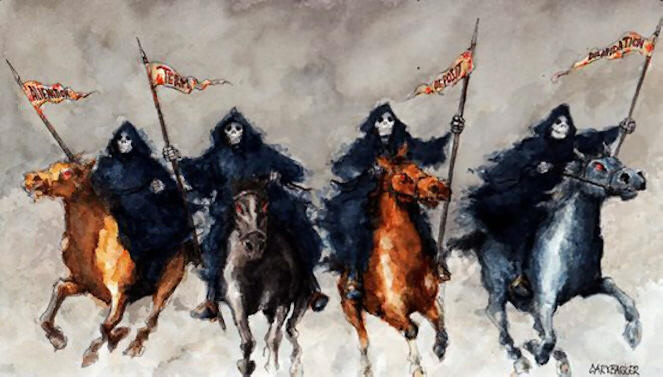
The Red Horse
When the Lamb opened the second seal, I heard the second living creature say, “Come and see!” Then another horse came out, a fiery red one. Its rider was given power to take peace from the earth and to make men slay each other. To him was given a large sword. ( Revelation 6:3-4)
Also known as War
Red equals blood and blood equals war. This rider takes peace from the earth. This seal is opened in the middle of the “tribulation”, when the Abomination of Desolation is set up in the Temple in Jerusalem. Jesus discussed this in Matthew 24. Let’s remember what war really is: When Euripides, the Greek playwright wished to depict warfare on the stage, he did not bring on an army with banners. He brought on a bent and bewildered old woman leading a weeping child by the hand who had lost her parents. That is war.
The second Horseman may represent civil war as opposed to the war of conquest that the first Horseman is sometimes said to bring. Other commentators have suggested that it might also represent the persecution of Christians. According to Edward Bishop Elliott's interpretation of the Four Horsemen as symbolic prophecy of the history of the Roman Empire, the second seal is opened and the Roman nation that experienced joy, prosperity and triumph is made subject to the red horse which depicts war and bloodshed — civil war. Peace left the Roman Earth resulting in the killing of one another as insurrection crept into and permeated the Empire beginning shortly into the reign of the Emperor Commodus.:147–148 . Elliott points out that Commodus, who had nothing to wish and everything to enjoy, that beloved son of Marcus Aurelius who ascended the throne with neither competitor to remove nor enemies to punish, became the slave of his attendants who gradually corrupted his mind. His cruelty degenerated into habit and became the ruling passion of his soul. Elliott further recites that, after the death of Commodus, a most turbulent period lasting 92 years unfolded during which time 32 emperors and 27 pretenders to the Empire hurled each other from the throne by incessant civil warfare. The sword was a natural, universal badge among the Romans, of the military profession. The apocalyptic figure indicated by the great sword indicated an undue authority and unnatural use of it. Military men in power, whose vocation was war and weapon the sword, rose by it and also fell. The unrestrained military, no longer subject to the Senate, transformed the Empire into a system of pure military despotism.
The Black Horse
When the Lamb opened the third seal, I heard the third living creature say, “Come and see!” I looked, and there before me was a black horse! Its rider was holding a pair of scales in his hand. Then I heard what sounded like a voice among the four living creatures, saying, “A quart of wheat for a day’s wages, and three quarts of barley for a day’s wages, and do not damage the oil and the wine!” (Revelation 6:5-6)
Also known as Famine and Hunger
It takes an entire day’s wages just to buy a quart of wheat. “Balances” reveal scarcity. Americans don’t worry about the availability of food in times of plenty. In these future days the price of food will skyrocket while millions have no access to food anyway. Worldwide famine is not hard to imagine. Witness it now in Central and Eastern Africa. In the event of serious crop failure, no part of the world is more than one year away from critical starvation and the rich U.S. is only two years away. Of the Four Horsemen, the black horse and its rider are the only ones whose appearance is accompanied by a vocal pronunciation. John hears a voice, unidentified but coming from among the four living creatures, that speaks of the prices of wheat and barley, also saying "and see thou hurt not the oil and the wine". This suggests that the black horse's famine is to drive up the price of grain but leave oil and wine supplies unaffected (though out of reach of the ordinary worker). One explanation for this is that grain crops would have been more naturally susceptible to famine years or locust plagues than olive trees and grapevines, which root more deeply. The statement might also suggest a continuing abundance of luxuries for the wealthy while staples, such as bread, are scarce, though not totally depleted such selective scarcity may result from injustice and the deliberate production of luxury crops for the wealthy over grain, as would have happened during the time Revelation was written. Alternatively, the preservation of oil and wine could symbolize the preservation of the Christian faithful, who used oil and wine in their sacraments.
According to Edward Bishop Elliott's interpretation, through this third seal, the black horse is unleashed — aggravated distress and mourning. The balance in the rider's hand is not associated with a man's weighing out bits of bread in scanty measure for his family's eating but in association with the buying and selling of corn and other grains. The balance during the time of the apostle John's exile in Patmos was commonly a symbol of justice since it was used to weigh out the grains for a set price. The balance of justice held in the hand of the rider of the black horse signified the aggravation of the other previous evil, the bloodstained red of the Roman aspect into the darker blackness of distress.: The black horse rider is instructed not to harm the oil and the wine which signifies that this scarcity should not fall upon the superfluities, such as oil and wine, which men can live without, but upon the necessities of life — bread.
In history, the Roman Empire suffered as a result of excessive taxation of its citizens. During the reign of Emperor Caracalla, whose sentiments were very different from the Antonines being inattentive, or rather averse, to the welfare of the people, he found himself under the necessity of gratifying the greed and excessive lifestyle which he had excited in the Army. During his reign, he crushed every part of the empire under the weight of his iron scepter. Old as well as new taxes were at the same time levied in the provinces. In the course of this history, the land tax, the taxes for services and the heavy contributions of corn, wine, oil and meat were exacted from the provinces for the use of the court, army and capital. This noxious weed not totally eradicated again sprang up with the most luxurious growth and going forward darkened the Roman world with its deadly shade.: In reality, the rise to power of the Emperor Maximin, whose cruelty was derived from a different source being raised as a barbarian from the district of Thrace, expanded the distress on the empire beyond the confines of the illustrious senators or bold adventurers who in the court or army exposed themselves to the whims of fortune. This tyrant, stimulated by the insatiable desires of the soldiers, attacked the public property at length. Every city of the empire was destined to purchase corn for the multitudes as well as supply expenses for the games. By the Emperor's authority, the whole mass of wealth was confiscated for use by the Imperial treasury — temples stripped of their most valuable offerings of gold, silver and statues which were melted down and coined into money.
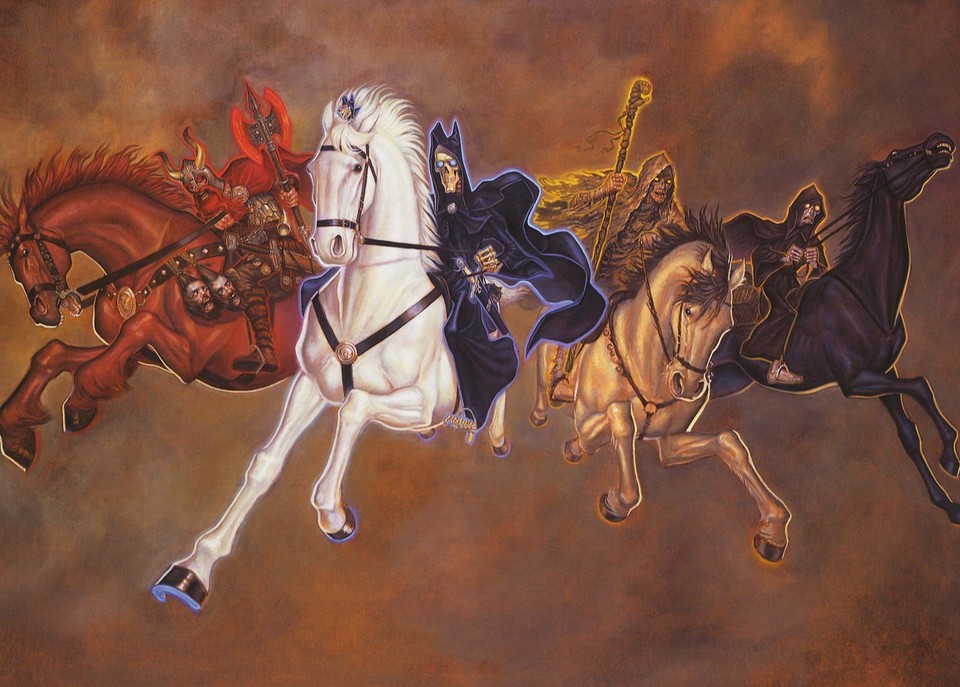
The Pale Horse
When the Lamb opened the fourth seal, I heard the voice of the fourth living creature say, “Come and see!” I looked and there before me was a pale horse! Its rider was named Death, and Hades was following close behind him. They were given power over a fourth of the earth to kill by sword, famine, and plague, and by the wild beasts of the earth. (Revelation 6:7-8)
Also known as Death
What is result of war and famine? Death. The word "Pale" is the Greek word for "green.” This is the ashen look of dead bodies without blood. In the science fiction movie, Soylent Green, the world is running out of food. The elites are given green blocks of food to eat and survive. Later in the movie, we discover that the green blocks are human remains dressed up for consumption. This is the pale horse. “One fourth of the people on earth die.” Currently, that’s about 2 billion people. This is an incredible amount of death. It’s estimated that only 100 million have died in all of the wars on earth to date! It sounds impossible to kill so many in such a short time. This couldn't be done in the days of the American Revolution. Soldiers then couldn’t load their muskets fast enough! But that all changed on August 6, 1945, in Hiroshima, Japan. Remember, as awful as this is, it is just a preview of coming attractions. As the 1,000 year millennial reign of Christ on earth is a preview of Heaven, so the Tribulation is a preview of Hell.
This fourth, pale horse, was the personification of Death with Hades following him jaws open receiving the victims slain by Death. Its commission was to kill upon the Roman Earth with all of the four judgements of God — with sword, famine, pestilence and wild beasts. The deadly pale and livid appearance displays a hue symptomatic of approaching empire dissolution. According to Edward Bishop Elliott, an era in Roman history commencing within about 15 years after the death of Severus Alexander (in 235 AD) strongly marks every point of this terrible emblem. Edward Gibbon speaks of a period from the celebration of the great secular games by the Emperor Philip to the death of Gallienus (in 268 AD) as the 20 years of shame and misfortune, of confusion and calamity, as a time when the ruined empire approached the last and fatal moment of its dissolution. Every instant of time in every province of the Roman world was afflicted by military tyrants and barbarous invaders — the sword from within and without. According to Elliott, famine, the inevitable consequence of carnage and oppression, which demolished the produce of the present as well as the hope of future harvests, produced the environment for an epidemic of diseases, the effects of scanty and unwholesome food. That furious plague (the Plague of Cyprian), which raged from the year 250 to the year 265, continued without interruption in every province, city and almost every family in the empire. During a portion of this time, 5000 people died daily in Rome; and many towns that escaped the attacks of barbarians were entirely depopulated. For a time in the late 260s, the strength of Aurelian crushed the enemies of Rome, yet after his assassination certain of them revived. While the Goths had been destroyed for almost a century and the Empire reunited, the Sassanid Persians were uncowed in the East and during the following year hosts of central Asian Alani spread themselves over Pontus, Cappadocia, Cilicia and Galatia, etching their course by the flames of cities and villages they pillaged.
As for the wild beasts of the earth, according to Elliott, it is a well-known law of nature that they quickly occupy the scenes of waste and depopulation — where the reign of man fails and the reign of beasts begins. After the reign of Gallienus and 20 or 30 years had passed, the multiplication of the animals had risen to such an extent in parts of the empire that they made it a crying evil. One notable point of apparent difference between the prophecy and history might seem to be expressly limited to the fourth part of the Roman Earth, but in the history of the period the devastations of the pale horse extended over all. The fourth seal prophecy seems to mark the malignant climax of the evils of the two preceding seals to which no such limitation is attached. Turning to that remarkable reading in Jerome's Latin Vulgate which reads "over the four parts of the earth," it requires that the Roman empire should have some kind of quadripartition. Dividing from the central or Italian fourth, three great divisions of the Empire separated into the West, East and Illyricum under Posthumus, Aureolus and Zenobia respectively — divisions that were later legitimized by Diocletian. Diocletian ended this long period of anarchy, but the succession of civil wars and invasions caused much suffering, disorder and crime which brought the empire into a state of moral lethargy from which it never recovered. After the plague had abated, the empire suffered from general distress, and its condition was very much like that which followed after the Black Death of the Middle Ages. Talent and art had become extinct in proportion to the desolation of the world.
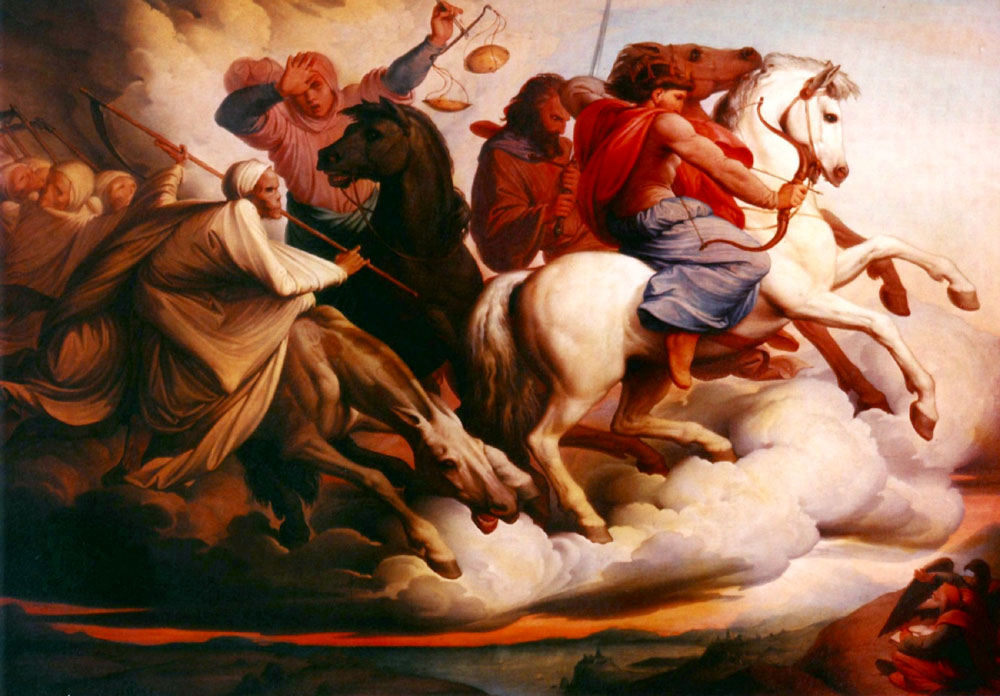
Links:
https://publicdomainreview.org/collections/the-four-horsemen-of-the-apocalypse/
https://en.wikipedia.org/wiki/Four_Horsemen_of_the_Apocalypse
https://www.gotquestions.org/four-horsemen-apocalypse.html
https://www.crosswalk.com/special-coverage/end-times/what-are-the-four-horsemen-of-the-apocalypse.html
https://www.crosswalk.com/church/pastors-or-leadership/ask-roger/what-are-the-4-horses-of-the-apocalypse-and-why-do-they-matter.html
All things on this page were taken from these pages, all I did was copy and paste in various orders, so these pages are credited above.
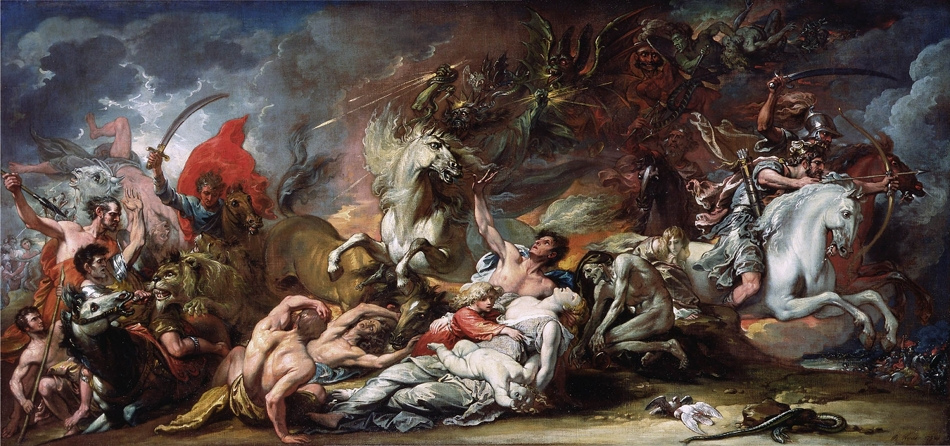
Our ACMs in Hell are titled the Four Horsemen : They are as follows:
Victorum:
She takes on the persona of Pestilence.
War:
No need to guess, her persona is obvious . It doesn't take a genius.
ABHORASH:
He takes on the persona of Famine.
~~Page Created by Saetan~~
NEW MEMBERS
Leech (2)
11:46 - April 01 2025

Whelp (1)
05:31 - April 01 2025

Whelp (1)
17:39 - March 31 2025
REAL VAMPIRES LOVE VAMPIRE RAVE
Vampire Rave is a member of
Page generated in 0.0465 seconds.










